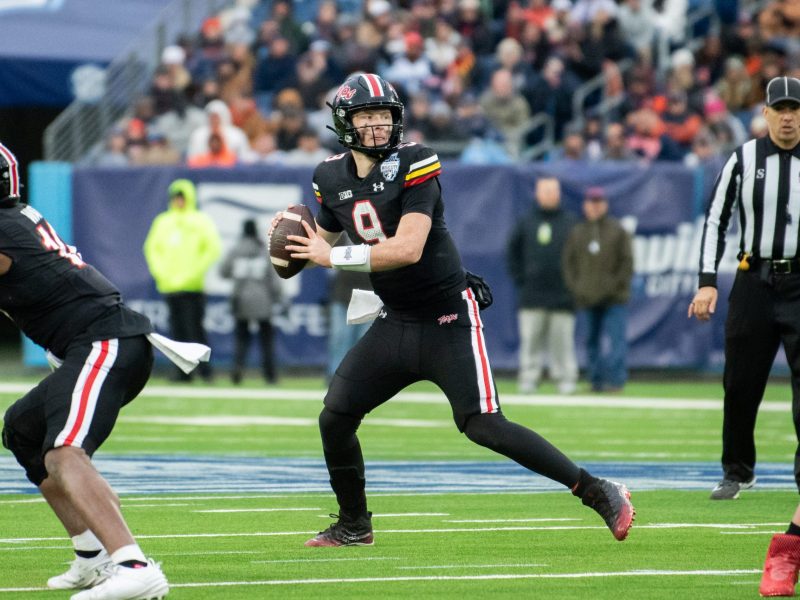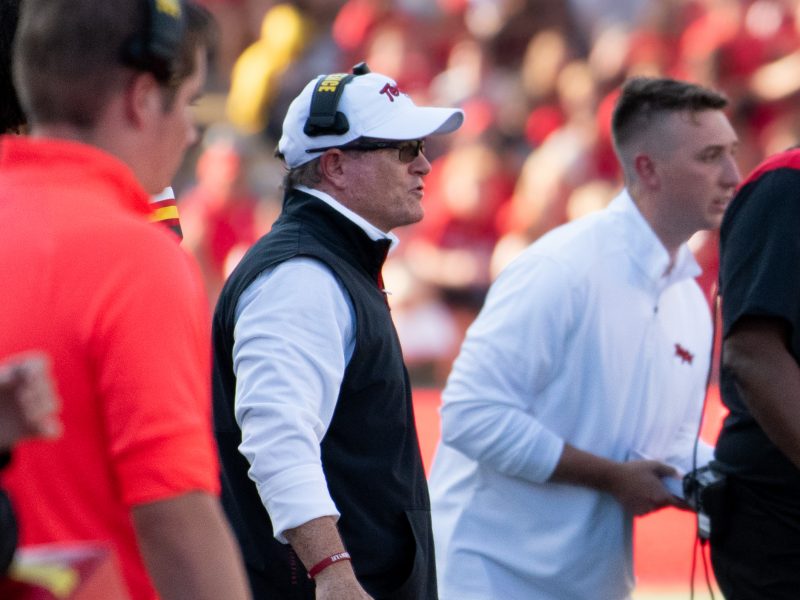Two years from now, when the members of Maryland football’s best recruiting class to date enter their junior years, they might still talk about the 2017 season.
They may not brag about the team’s record, which will probably be worse than last season’s, or discuss trips to Ohio State and Wisconsin — likely defeats the youngsters will aim to forget.
But they may discuss how the 2017 campaign was the stepping stone toward becoming a conference contender. After years of getting blown out by ranked teams, whether in the Big Ten or ACC, Maryland is headed for competitiveness.
Fresh off a 6-7 season that ended in a bowl game loss to Boston College, Maryland will face arguably the toughest schedule in the country. No. 23 Texas, No. 2 Ohio State, No. 9 Wisconsin, No. 11 Michigan and No. 6 Penn State highlight the Terps’ daunting foes.
Boosted by the 18th-best recruiting class in the country, the on-field talent should be better. But given the daunting slate of games, the results will likely be worse. Maryland will probably win around five games and finish on the bubble of making a bowl game.
Even if their record doesn’t imply progression, the Terps will take the program’s biggest step toward becoming what coach DJ Durkin has envisioned since being named head coach in December 2015 — a contender in one of the country’s toughest conferences.
“It’s natural for us to take our next step as a program,” Durkin said. “There’s a lot that’s been made that we’re a young team and all that. Yeah we are, I don’t know, but I think we’re pretty good. … This whole thing is a process. It’s building.”
Maryland fans have used football as a bridge to basketball season since the 1970s. Hype around football often dies when conference season rolls around and Maryland can’t stick with the country’s national powerhouses. The Terps have one conference title since 1985.
So, why will this year be the last time Maryland rolls over against the best of the best? It starts with one of the top recruiters in the country.
Durkin brought in the best recruiting class in program history in his first full attempt with the Terps. He’s followed that up with a strong Class of 2018, which 247Sports currently ranked 16th, above USC and Alabama.
While defensive lineman Jesse Aniebonam said the influx of talent matters only if players learn to work together, cohesion should not be an issue.
Many of the Terps’ top signings received interest from traditionally strong programs, such as Alabama, Ohio State, Michigan, Georgia and Penn State. Yet they bought into a program that finished with a combined 9-16 record in the past two seasons.
They came here to help Maryland win Big Ten championships — not to set personal records or up their draft stock.
That leadership begins with the quarterback of Maryland’s future — Kasim Hill. After the four-star gunslinger committed to the Terps’ 2017 class, he helped them seal big-time recruits, including seven other four-star 2017 prospects, according to 247Sports.
Hill may not start Maryland’s season opener at Texas on Saturday, but he could serve under center by midseason given mixed showings from quarterbacks Tyrrell Pigrome and Max Bortenschlager.
Even if Hill takes time to acclimate to the college game, he possesses the athleticism, instincts and poise to become a household name by his sophomore year.
The rest of Maryland fans’ dreams go like this: Anthony McFarland becomes one of the nation’s best running backs, Jordan McNair and Marcus Minor protect Hill in the pocket, Deon Jones and Markquese Bell drive receivers crazy with their NFL-ready bodies and Cam Spence and twins Breyon and Brandon Gaddy torture some of the best quarterbacks in the country.
For the first time in years, those are realistic hopes. And that’s just some of the Terps’ future outlined. Twenty recruits, including three four-stars, have verbally committed to Maryland for 2018.
“I have no problem playing freshmen,” Durkin said. “Some guys are ready to do it, and even if some aren’t, it’s not indicative of how their whole careers are going to go. We’re not going to say, ‘I think this guy can do it, but it’s a freshman.’ No. If he can do it, we’re going to put him out there to do it.”
Maryland still doesn’t have the national recruiting presence of other top Big Ten teams. But from a reliance on local recruits, the Terps are building a group that could yield the next wave of NFL players from College Park.
The Terps have recently featured stars who developed into formidable professional players, such as Stefon Diggs, Vernon Davis, Shawne Merriman and Torrey Smith. But this will be the first time since their 2002 Orange Bowl appearance the Terps have had this much skill on one team.
That talent may or may not blossom this year. But it will eventually.
This is the last campaign spectators will diminish the Big Ten for adding Maryland due to its lack of football success. It’s the last year people will laugh at Maryland’s box scores against Ohio State and Michigan. Soon, victories against teams like Illinois, Minnesota and Indiana will become more certain.
It’s not crazy to think Maryland will become a Big Ten contender soon. Washington made the College Football Playoff last year after failing to win at least six conference games in 14 consecutive seasons. Chris Petersen rejuvenated that program when he became coach in 2014. Durkin can do the same.
“We’re getting closer and closer every day,” Durkin said. “We’re here to win championships.”
The Terps’ most challenging schedule in years can perhaps spur that leap.



